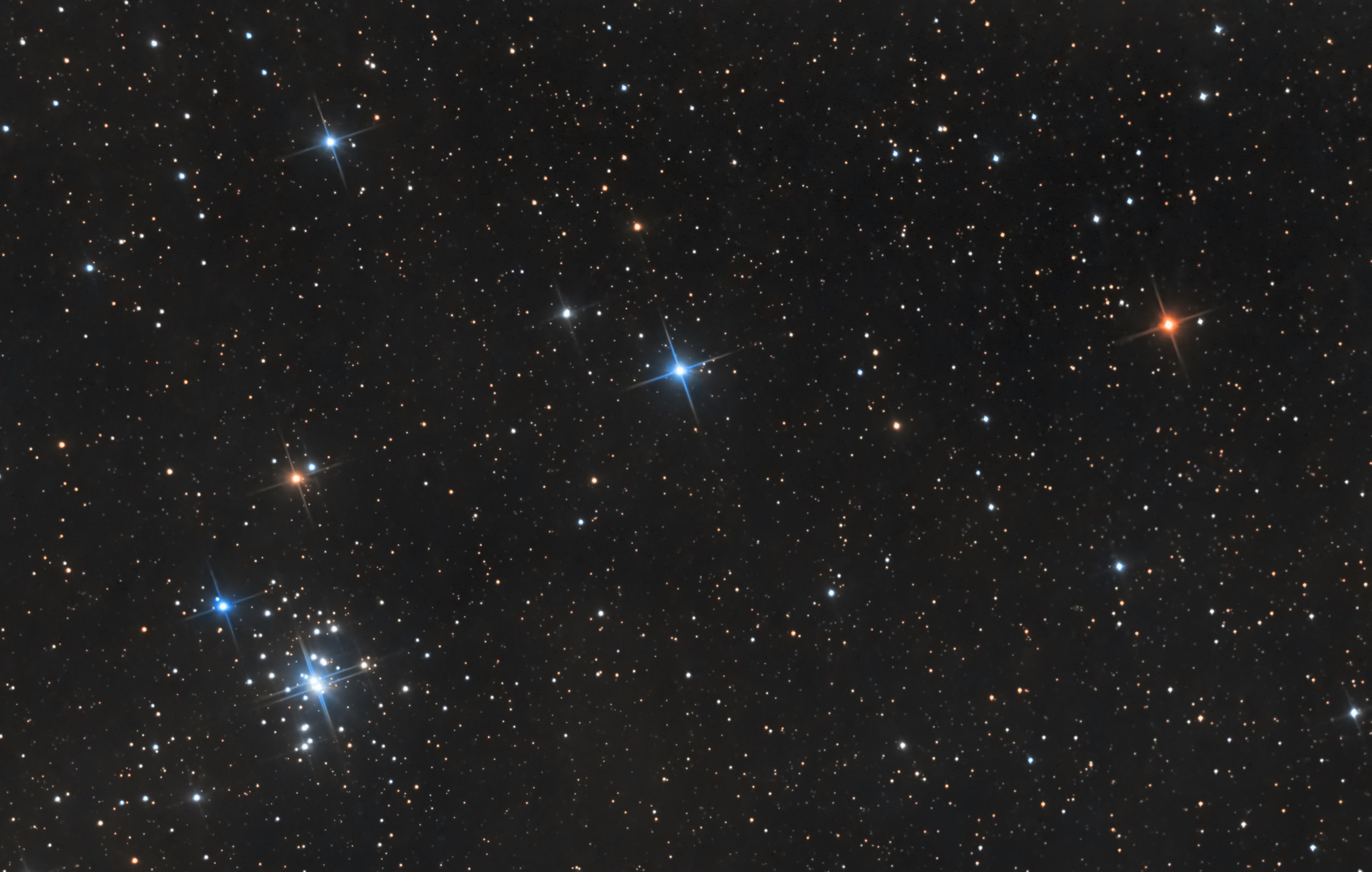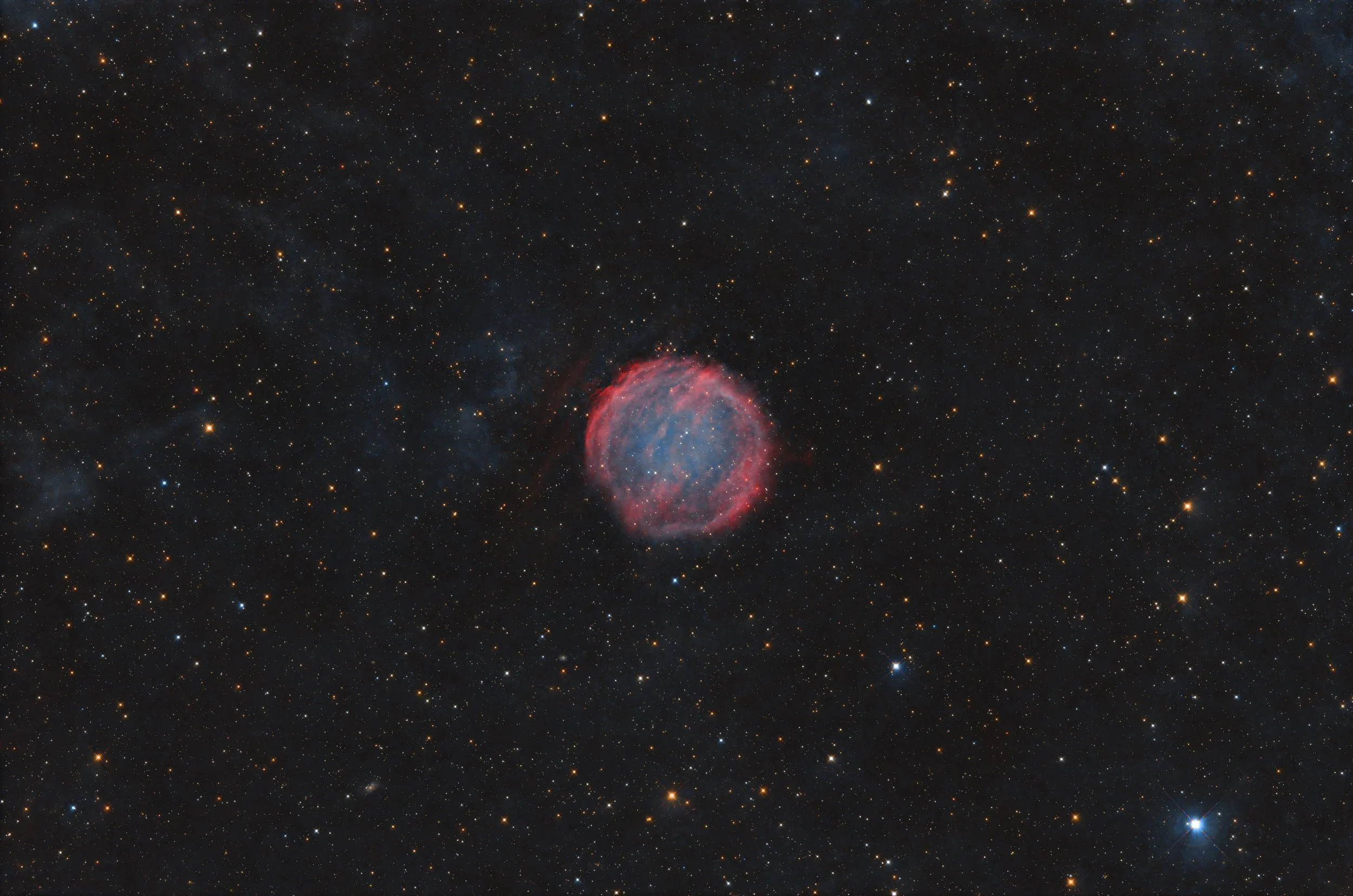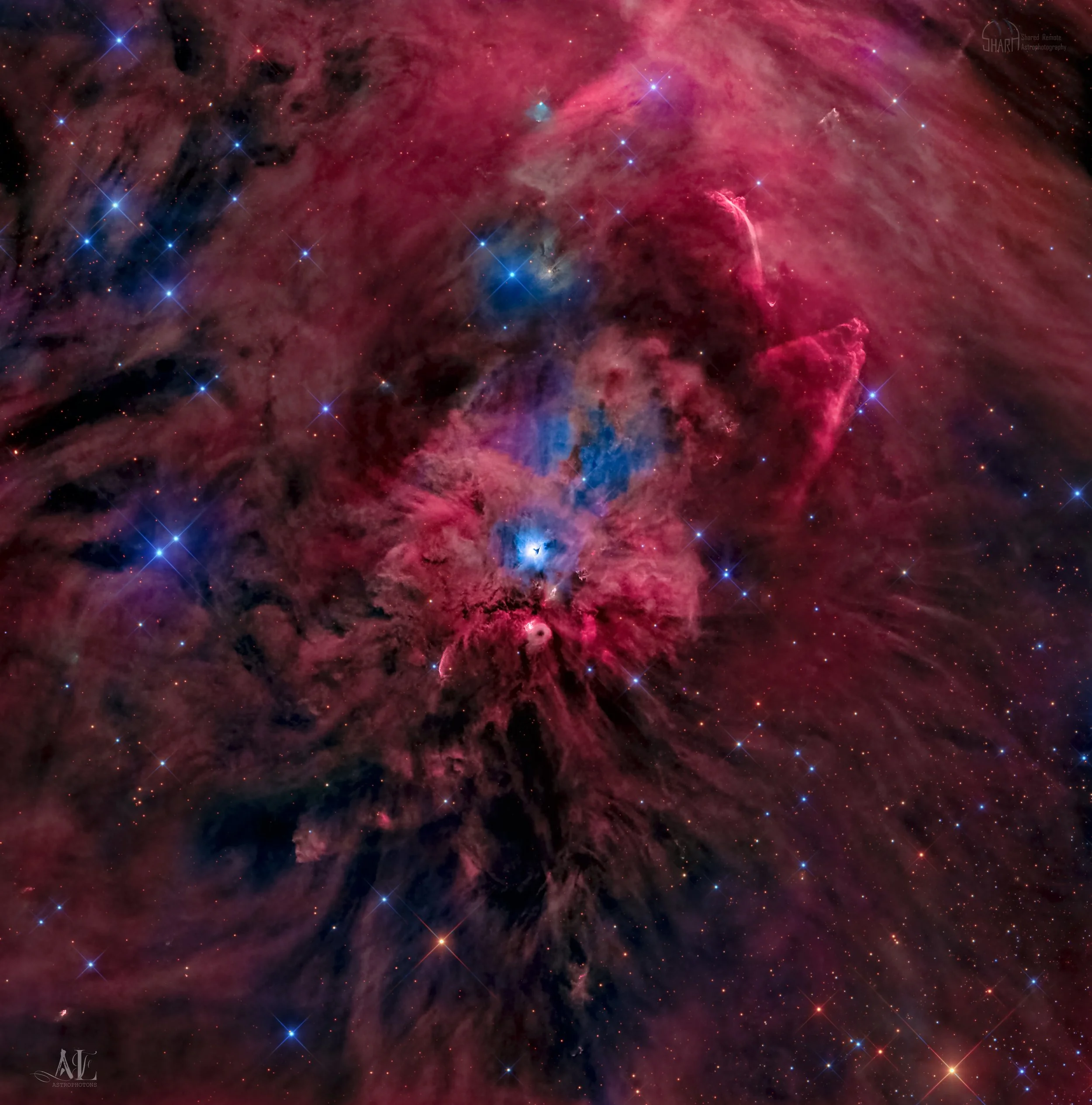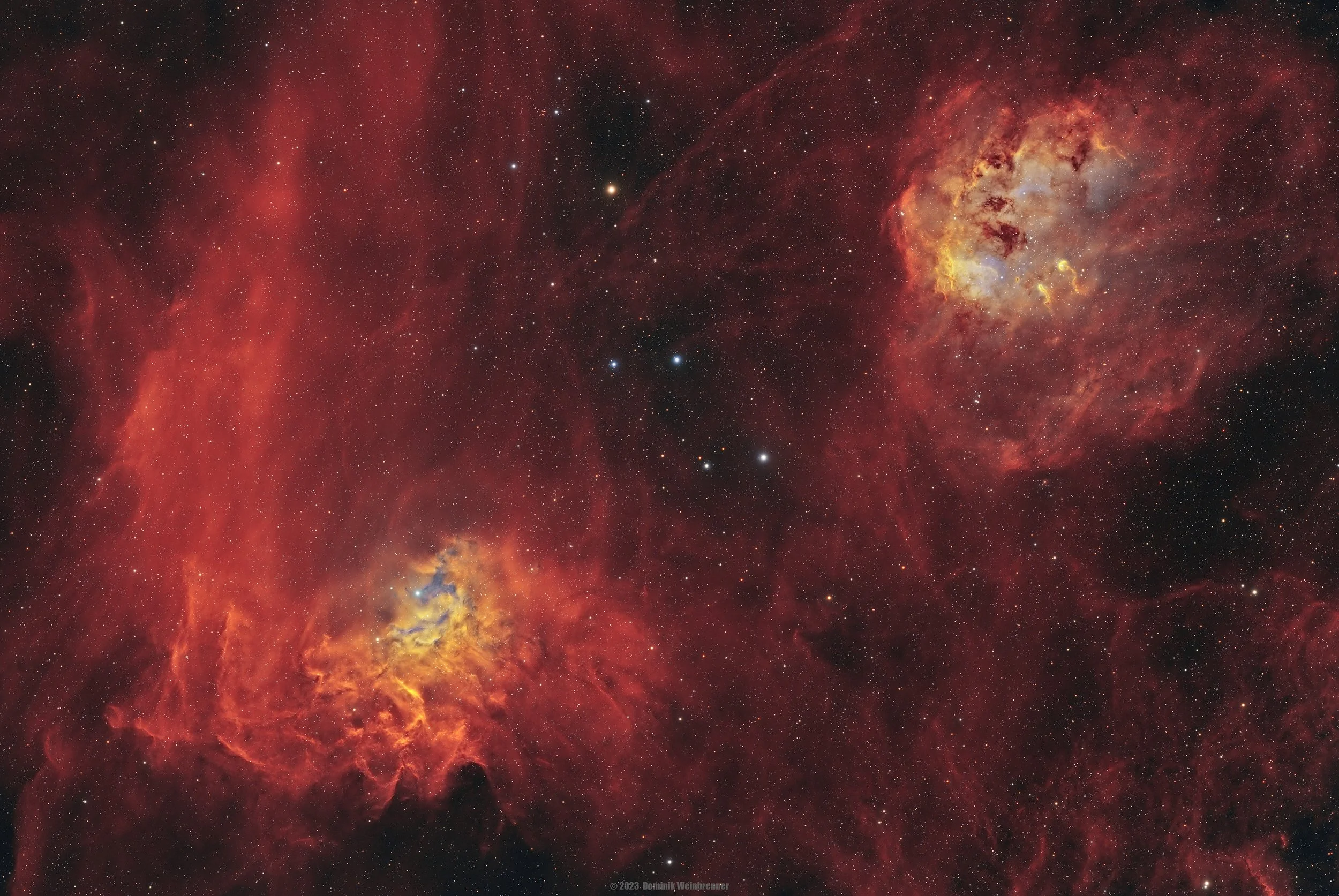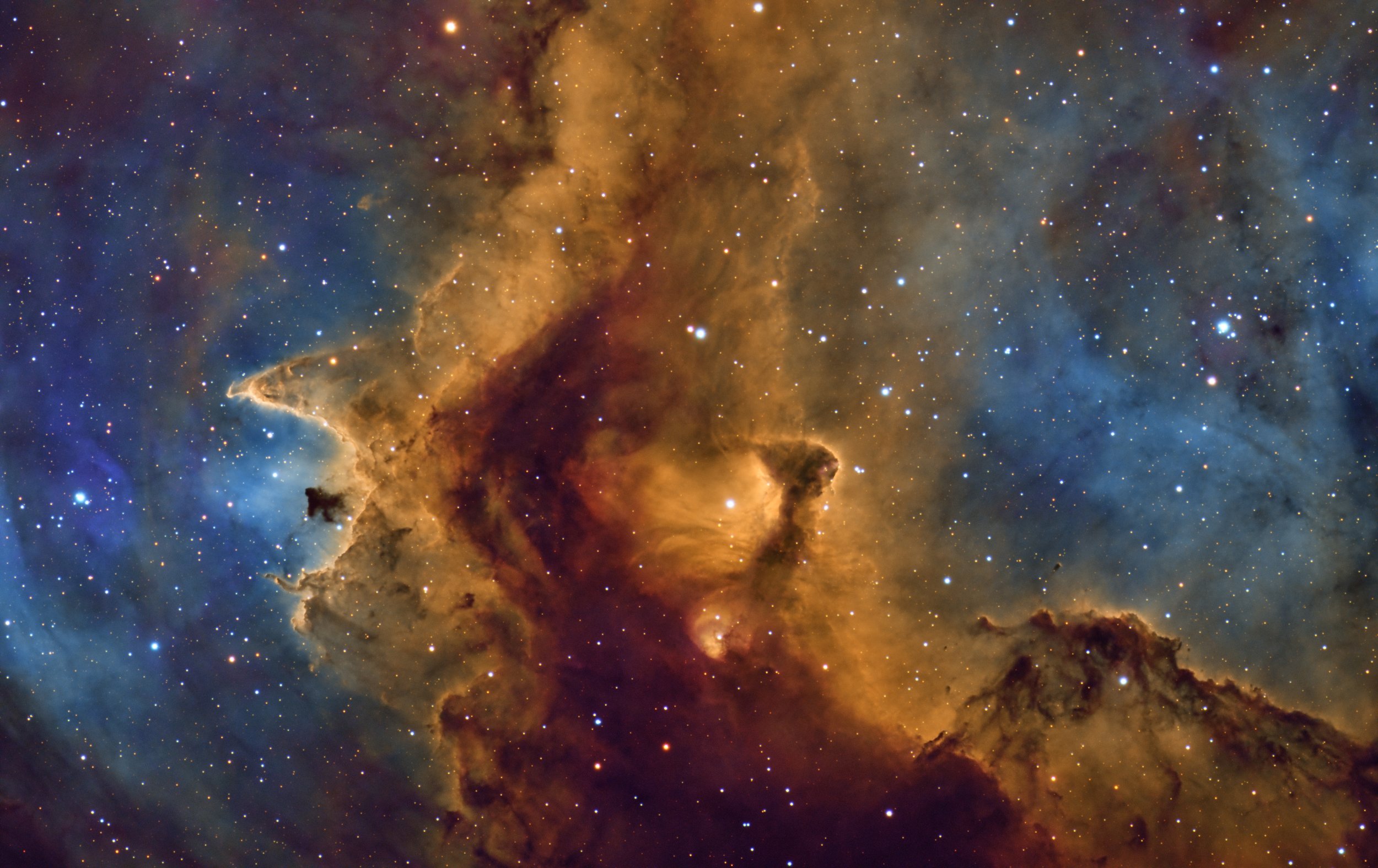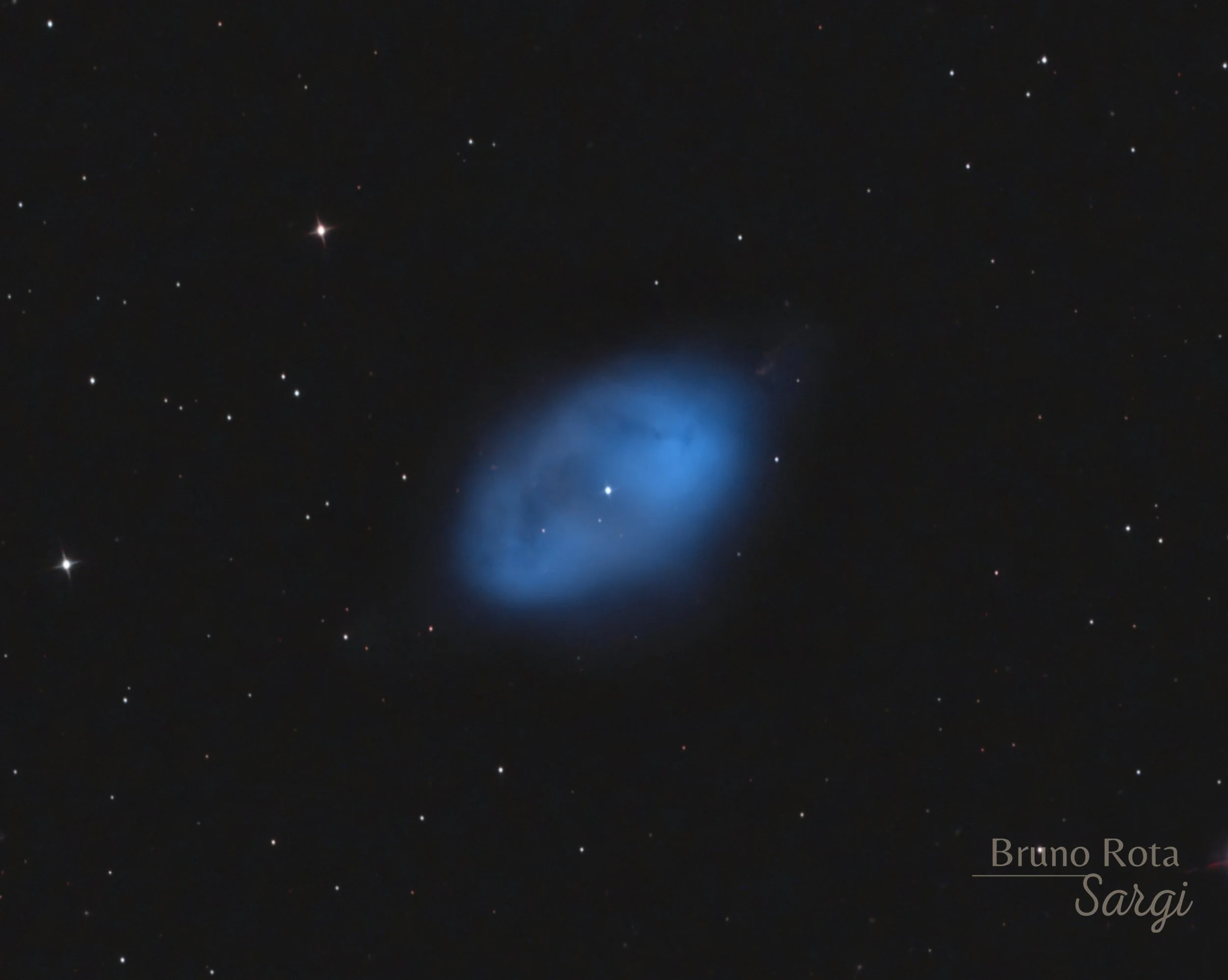
AAPOD2 Image Archives
Seven Sisters rolling in the deep
In this wide-field view of the Pleiades, AKA Messier 45 (M45), the image not only presents a visual feast but also unveils several intriguing facts about this prominent open star cluster. Composed of hot, blue, and luminous stars, the Pleiades is a young cluster, estimated to be around 100 million years old. The association of these stars with a common origin in a molecular cloud showcases the dynamics of stellar birth and evolution within our cosmic neighborhood.
Robin’s Egg Nebula
NGC 1360 is interesting for several reasons:
First, it is one of the few planetary nebulae where an intense stellar magnetic field has been observed. Indeed, the central star of this nebula has an intense magnetic field observed and the fast wind is no longer present, which indicates that a reflux process has probably developed.
Secondly, the nebula shows an elongated morphology and almost without relief, with no apparent glossy edge, no clear inner boundary or central cavity. The absence of a central cavity explains and confirms the absence of fast stellar winds.
Third, This nebula presents a bipolar jet of matter from its host star.
Jupiter, Europa, Io & Ganymede
Captured in this mesmerizing photo is a celestial ballet featuring three of Jupiter's four principal moons. The scene unfolds in the wake of the great red spot's transit, showcasing a region rife with turbulence and captivating details. This rare event, documented with precision and awe, offers a glimpse into the dynamic and ever-changing atmosphere of the gas giant.
The trio of moons, possibly including the Galilean satellites Io, Europa, and Ganymede, adds a celestial charm to the tumultuous aftermath of the great red spot's journey across Jupiter's surface. The turbulent backdrop paints a vivid cosmic canvas, inviting viewers to witness the intricate interplay of atmospheric elements in this dynamic region.
Observing and recording such a rare event fills the soul with wonder and amazement. The ethereal dance of Jupiter's moons amidst the turbulent atmosphere becomes a testament to the beauty and unpredictability of the cosmos. This celestial ballet, frozen in time, serves as a reminder of the ever-shifting nature of our solar system and the continuous spectacle of celestial wonders that unfold in the vastness of space.
NGC 1502
Amidst the cosmic symphony that welcomes the dawn of a new year, NGC 1502 emerges as a celestial dance in the constellation Perseus. This open star cluster, bathed in the soft glow of interstellar dust, invites us to witness the beauty of stellar companionship and the intricate choreography of its member stars.
NGC 1502, a gem in the celestial realm, features a central concentration of stars forming a tight-knit cosmic ensemble. The cluster's ethereal glow, painted against the cosmic backdrop, encapsulates the essence of unity and shared radiance, much like the collective aspirations that accompany the onset of a new year.
As we gaze upon NGC 1502, we are drawn into a celestial revelry where stars, each with its unique brilliance, join in a dance of gravitational interplay. The stellar companionship within the cluster mirrors the spirit of collaboration and mutual support, resonating with the hopes and dreams that mark the beginning of a fresh cosmic chapter.
NGC 1502 becomes a metaphorical celestial ballroom, where stars twirl and pirouette in the vastness of space. This New Year, let us be inspired by the harmonious dance of NGC 1502, fostering connections, embracing unity, and embarking on a journey of shared brilliance under the cosmic expanse.
Burning Orion-Nebula m42
As we step into the pristine canvas of a new year, the celestial stage is set ablaze with the resplendent glory of M42, the Orion Nebula. This cosmic masterpiece, situated in the iconic Orion constellation, becomes a stellar beacon, symbolizing the promise of fresh beginnings and the awe-inspiring beauty of the cosmos.
M42, also known as the Great Orion Nebula, serves as a metaphorical firework display in the heavens, igniting the night sky with vibrant hues of ionized hydrogen and intricately woven tendrils of dust and gas. This astronomical spectacle, visible to the naked eye, captures the imagination with its stellar brilliance and complex interplay of cosmic forces.
As we celebrate the onset of the new year, the Orion Nebula becomes a cosmic time capsule, offering a glimpse into the stellar nurseries where new stars are born. The Trapezium Cluster at its heart, a gathering of young and energetic stars, mirrors the collective spirit of anticipation and excitement that accompanies the turning of the cosmic calendar.
Much like the burst of fireworks heralding the stroke of midnight, M42 encapsulates the grandeur of celestial creation and the cyclical nature of time. It beckons us to peer into the cosmic tapestry, where the threads of stellar birth and renewal intertwine, inviting contemplation and wonder as we embark on a new journey around the sun.
So, let the ethereal glow of M42 guide us into the new year, a celestial overture that inspires reflection, dreams, and the timeless appreciation of the universe's perpetual dance.
PuWe 1 or PN G158.9+17.8 in HOO with LRGB Stars
In the cosmic tapestry of New Year's Eve, PuWe 1, also known as PN G158.9+17.8, emerges as a celestial timepiece in the constellation Cassiopeia. This captivating planetary nebula, resembling an intricate hourglass suspended in the vastness of space, captures the essence of our earthly countdown to a new year.
The hourglass shape of PuWe 1 becomes a metaphor for the passage of time, each grain of celestial sand representing a moment in the cosmic journey. The central star, having exhausted its nuclear fuel, sheds its outer layers in a mesmerizing dance, creating the delicate structure that enchants astronomers and stargazers alike.
As we stand on the threshold of the new year, PuWe 1 invites us to reflect on the year that has passed, just as the sands of time gracefully slip through the celestial hourglass. The intricate details of this planetary nebula serve as a reminder that, much like the cosmic dance unfolding within PuWe 1, our own lives are part of a grand celestial ballet.
So, let us gaze into the cosmic hourglass of PuWe 1 on this New Year's Eve, appreciating the beauty of the celestial clockwork and embracing the promise of new beginnings as the clock strikes midnight in the cosmos.
NGC 1999: The cosmic key hole
NGC 1999, nestled in the constellation Orion, unfolds its captivating features in this image. Renowned for the enigmatic "Dark Bay," a distinct dark patch within the nebula, NGC 1999 is a reflection nebula that stands out against the luminous backdrop of surrounding star-forming regions. The intricate interplay of colors, attributed to the scattering of starlight by fine dust particles, adds to the visual allure of this cosmic masterpiece.
At the heart of NGC 1999 lies the young stellar object V380 Orionis, a protostar that illuminates the surrounding dust and gas, contributing to the nebula's luminosity.
The Dark Bay within NGC 1999 is believed to be a dense region of dust and gas that intricately obscures background starlight, creating a visually striking contrast within the nebula. This unique feature adds to the intrigue of NGC 1999.
A Fire In Auriga
In this captivating bi-color image, the dynamic duo of IC 410 and IC 405 unfolds in the cosmic canvas, revealing the ionized gases captured through hydrogen alpha (Ha) and oxygen (OIII) filters. IC 410, also known as the Tadpoles Nebula, unveils its reddish hues, showcasing regions of intense star formation and ionized hydrogen. Meanwhile, IC 405, the Flaming Star Nebula, bathes in the greenish-blue glow of oxygen emissions.
The Tadpoles Nebula within IC 410 features elongated structures resembling tadpoles, sculpted by the powerful stellar winds and radiation emanating from massive stars within the nebula.
Illuminated by the runaway star AE Aurigae, IC 405 is believed to have been ejected from the Orion Trapezium Cluster millions of years ago, contributing to the unique dynamics of this cosmic region.
NGC 2736 Pencil Nebula in HOO
NGC 2736, also recognized as the Pencil Nebula. Situated in the Vela constellation, this elongated nebula is a remnant of a supernova explosion, showcasing intricate tendrils of ionized hydrogen and oxygen gases.
The hydrogen alpha emissions, depicted in red, highlight regions of intense star formation and energetic interactions. The oxygen emissions, represented in greenish-blue, offer insights into the nebula's chemical composition and the aftermath of the supernova explosion.
The Pencil Nebula is part of the larger Vela Supernova Remnant, an expansive shell of gas and dust resulting from the cataclysmic death of a massive star. This supernova event likely occurred thousands of years ago, and the Pencil Nebula serves as a testament to the transformative forces unleashed in such stellar explosions.
The delicate structure of the Pencil Nebula is sculpted by the shockwaves generated during the supernova explosion. These shockwaves compress and heat the surrounding interstellar material, giving rise to the nebula's intricate filaments and wisps.
IC 5148 (Spare Tyre Nebula) Planetary Nebula
IC 5148, also known as the Spare Tyre Nebula, graces the cosmic stage in this captivating astrophotograph rendered in RGB (Red, Green, Blue) colors. Situated in the constellation Grus, this planetary nebula unveils its intricate details through a mosaic of stellar emissions and cosmic interactions.
The image showcases the nebula's inner regions with emissions predominantly in red, capturing the essence of ionized hydrogen. This region marks the culmination of a Sun-like star's life, shedding its outer layers to form the nebula's intricate structure. The interplay of green and blue hues, emanating from the surrounding oxygen-rich shells, offers a visual narrative of the star's complex death throes.
The Spare Tyre Nebula's distinct morphology, resembling a spare tire or donut, is a testament to the intricate interplay of stellar winds, radiation, and the surrounding interstellar medium.
The Seven Sisters
M45, commonly known as the Pleiades or the Seven Sisters, presents a captivating celestial panorama with distinctive blue hues in astrophotographs. The dominant reason behind this intense blue appearance lies in the interstellar dust surrounding the stars within the cluster. As starlight passes through this cosmic dust, it undergoes a process known as Rayleigh scattering.
Rayleigh scattering, more commonly associated with why the Earth's sky appears blue during the day, occurs when short wavelengths of light (such as blue) scatter more effectively than longer wavelengths (such as red). In the case of the Pleiades, the blue light from the stars is scattered by the intervening interstellar dust, resulting in the cluster's pronounced blue coloration when captured through astrophotography.
This scattering phenomenon not only contributes to the distinct visual beauty of the Pleiades but also serves as a valuable astrophysical tool for astronomers. By studying the extent of this scattering, scientists can gain insights into the distribution and properties of the intervening interstellar material, providing a deeper understanding of the cosmic environment surrounding this iconic star cluster.
Elephant's Trunk Nebula in SHO with RGB stars - IC 1396A
Nestled within the expansive star-forming region IC 1396 in the Cepheus constellation, the Elephant's Trunk Nebula, denoted IC 1396A, emerges as a captivating celestial structure. This elongated globule of dense dust and gas has earned its moniker due to its striking resemblance to an elephant's head and trunk at visible wavelengths, where a dark, shadowy region is surrounded by a luminous, winding rim. Positioned approximately 2,400 light-years from Earth, the nebula offers a unique insight into the intricacies of star formation and the interplay of cosmic forces within the vast expanse of IC 1396.
Lesser-known fact: The Elephant's Trunk Nebula is a prominent site for ongoing research, with astronomers studying its molecular content and magnetic fields to deepen our understanding of the complex processes shaping stellar birth and evolution in this captivating corner of the universe.
IC 1871
IC 1871 reveals its intricate details through the specialized SHO (Sulfur, Hydrogen, Oxygen) narrowband palette. Using narrowband filters, the image unfolds the cosmic tapestry of ionized gases within IC 1871. The sulfur, hydrogen, and oxygen emissions, represented by distinct colors, expose the nebula's composition and the energetic processes at play. Situated against the backdrop of the cosmos, IC 1871 becomes a stellar subject for both aesthetic appreciation and scientific exploration, offering astronomers a closer look at the nebula's chemical makeup and the astrophysical phenomena shaping its luminous features.
Sh2-223 and Sh2-224 - 2 Panel Mosaic
In this two-panel mosaic of Sh2-223 and Sh2-224 reveals a dynamic interplay of ionized gases and stellar nurseries. Captured through a meticulous blend of imaging data, this celestial composition showcases the radiant hues of hydrogen alpha emissions, portraying the energized regions where massive stars shape their surrounding nebulae. Positioned within the Milky Way, these emission nebulae offer astronomers valuable insights into the ongoing processes of star formation and the sculpting forces of interstellar space.
The Left Arm of Cepheus (287 hrs)
This area of Cepheus doesn't get a lot of attention. There's no Elephant Trunk nebula, no Bat or Squid nebula, no Wizard nebula, no Iris Nebula. So naturally, I wanted to take some time and get a really deep integration on it, to try for a unique view.
Maybe the most interesting thing in this photo is the small blue blob of Oiii (with a sharp Ha/Sii arc) that's about 20% over from the left side of the image, and about a third of the way up from the bottom. At some point during data acquisition, the Oiii just started showing up. I thought it was dust in my imaging train, but after re-taking my flats, the Oiii was still there. Jaša Rebula was able to figure out that the area had been cataloged as supernova remnant Te 12….
M31 and Surrounding Features
We would like to submit the attached image as a candidate for this competition. We are a small community of astrophotographers with similar equipment who collaborate on different projects; we coined the name “Association of Widefield Astrophotographers” because of the wide field of view that our budget gear provides. The image is a 100 hour project with data from 6 different contributors. It features the famous Andromeda Galaxy, (M31) and its extensive outer halo. Our deep broadband integration also revealed faint IFN structures surrounding the galaxy. The 87 hours of narrowband data …
Geminid bolides
Captured by a the lens of a DSLR at Millstätter See, Kärnten, Austria, this Geminids meteor fireball exhibits its blazing descent through Earth's atmosphere. The meteor, likely originating from debris shed by asteroid 3200 Phaethon, leaves a distinctive smoke trail in its wake. This image not only documents the annual Geminids meteor shower but also offers a scientific glimpse into the meteor's composition and dynamics. The lingering smoke trail is a result of the meteoroid's interaction with the atmosphere, as its high-speed entry causes ablation and ionization, releasing visible particles. This visual record provides astronomers valuable data to understand the physical properties of meteors and their atmospheric interactions during these celestial events.
The Small Magellanic Cloud
The Small Magellanic Cloud (SMC), a celestial jewel in the southern hemisphere, graces the night sky with its ethereal presence. Nestled among the distant stars, this dwarf irregular galaxy, a satellite of our Milky Way, captivates astronomers and stargazers alike. With an approximate distance of around 200,000 light-years, the SMC unveils a tapestry of stellar marvels, from sprawling nebulae to clusters of newborn stars. Its unique position allows astronomers to study cosmic phenomena with a distinct perspective, offering insights into the evolution of galaxies and the interplay of celestial forces.
Robin's Egg Nebula (NGC 1360)
NGC 1360, positioned in the constellation Fornax, unfolds as a planetary nebula, offering a unique astronomical insight into the final stages of stellar evolution. Located approximately 2,000 light-years away, this celestial object showcases a symmetrical structure, characterized by the luminous emission of ionized gases. The central star, concealed within the nebula's brilliance, represents a stellar remnant undergoing a transformative phase, shedding its outer layers into the interstellar medium.




